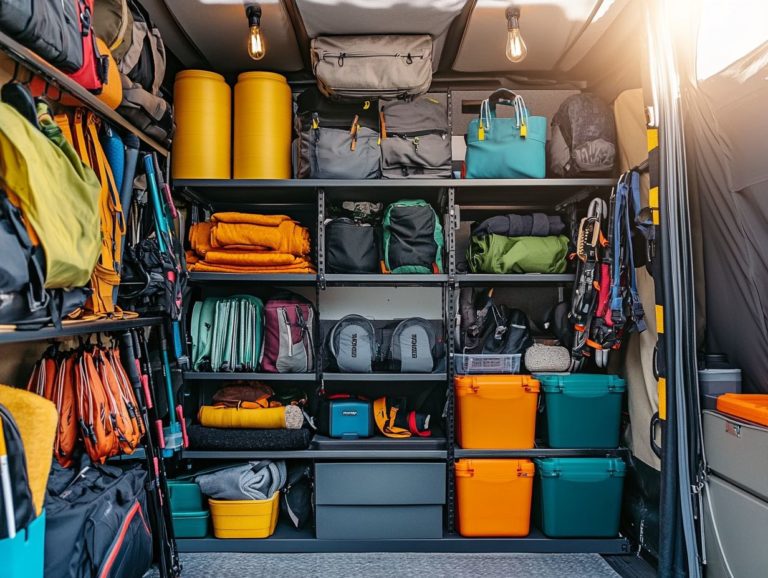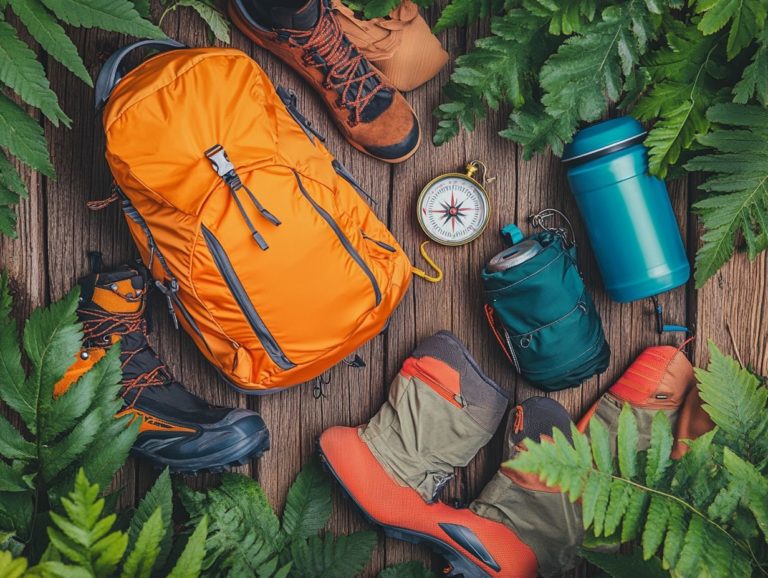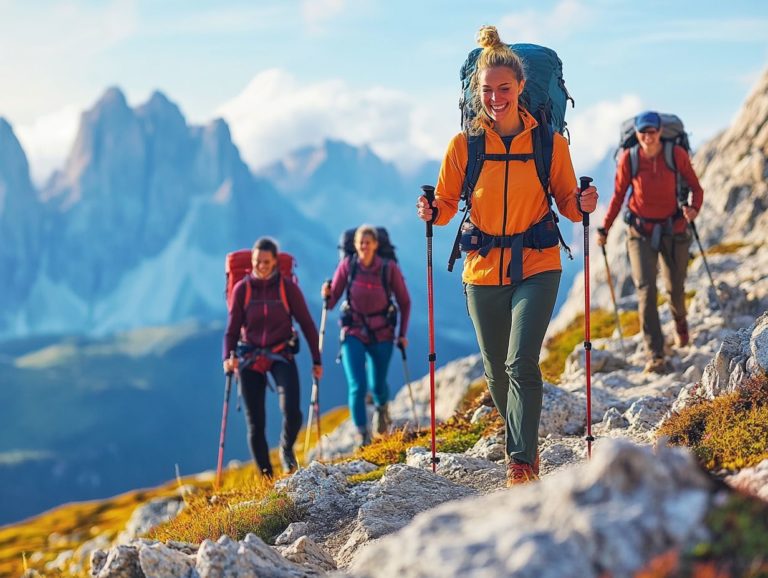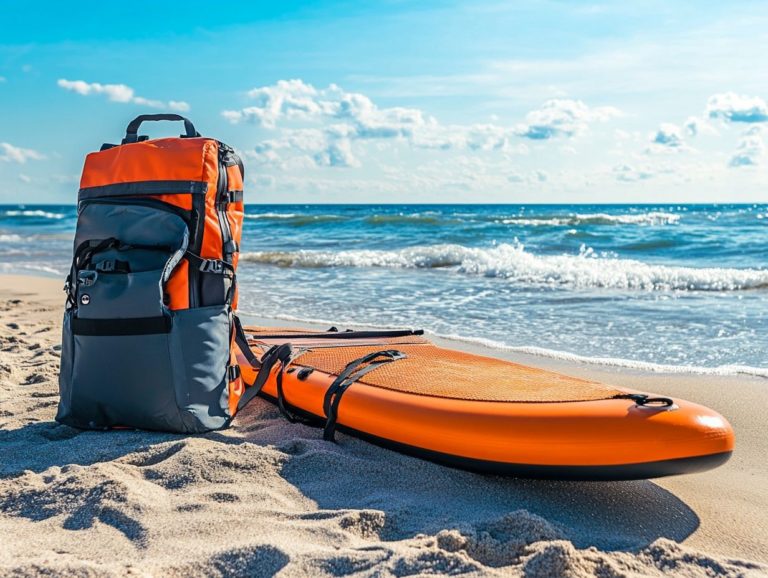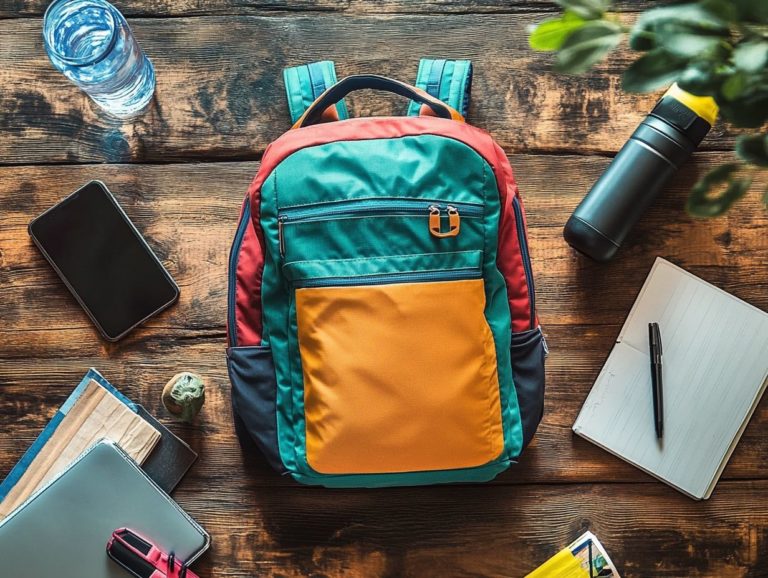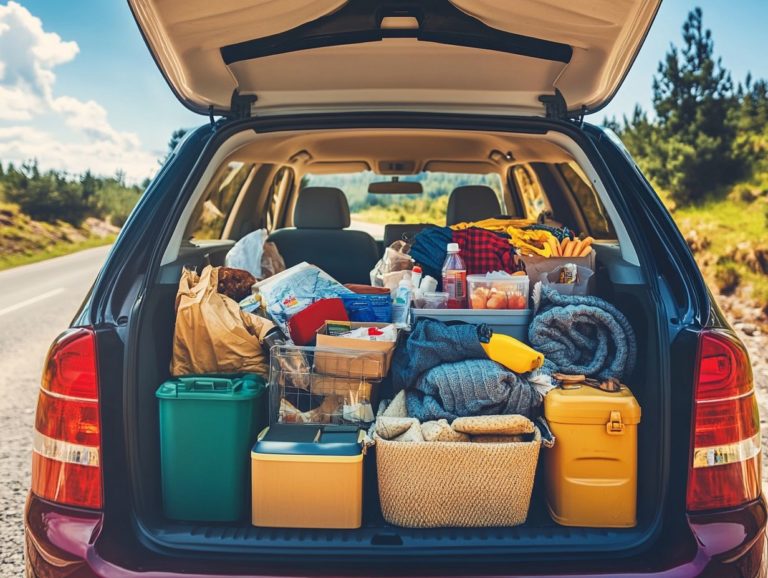Climbing Gear: What to Know Before You Go
Climbing is an exhilarating adventure that demands the right gear to ensure both safety and enjoyment.
Whether you re a novice conquering your first rock face or an experienced alpinist tackling icy summits, understanding the different types of climbing and the essential equipment required can truly enhance your experience.
This guide will delve into crucial gear such as ropes and harnesses, optional tools for specialized climbs, tips for selecting the best equipment, and maintenance advice to keep your gear in top condition.
Get ready to conquer your next climb with the right gear!
Contents
Key Takeaways:
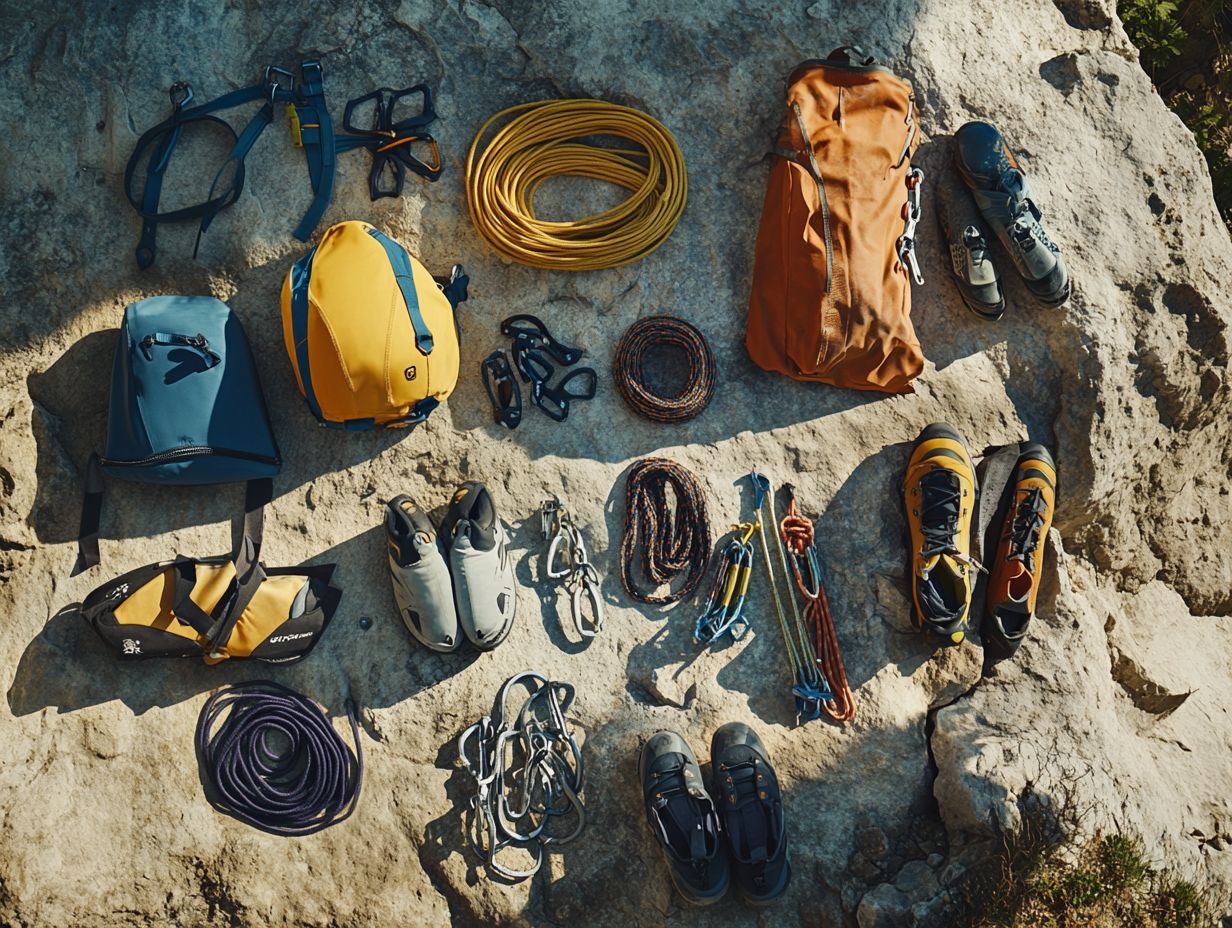
- Always invest in essential gear like ropes, harnesses, and helmets to ensure safety while climbing.
- Consider additional equipment for specific types of climbing, such as ice axes for ice climbing or quickdraws for sport climbing.
- Proper care and maintenance of climbing gear can greatly extend its lifespan, saving you money in the long run.
Types of Climbing and Required Gear
Understanding the different types of climbing is essential for anyone looking to elevate their climbing experience. Each style, whether it’s bouldering or traditional climbing, comes with its own set of specialized outdoor gear designed to meet the unique challenges of the climbing environment.
As you navigate the rocky terrains of Boulder, Colorado, or take on the iconic routes of Yosemite, choosing the right climbing gear becomes crucial for both your safety and performance.
The climbing community offers valuable tips on the best techniques and gear recommendations, making it much easier for you to embark on your outdoor climbing adventure.
Essential Gear for Climbing
Equipping yourself with the right gear for climbing is crucial for ensuring your safety and enhancing your performance. Reliable climbing harnesses, lightweight helmets, and durable climbing ropes are essential for effectively navigating challenges.
Don’t overlook other important items like belay devices, which help manage rope during climbing, chalk bags to improve your grip, and climbing apparel made from quick-drying, breathable materials. For those gearing up for a trip, exploring the best climbing gear for outdoor adventures can significantly enhance your overall experience.
Ropes, Harnesses, and Helmets
Ropes, harnesses, and helmets form the essential trio of climbing safety and performance, allowing you to embrace your adventures with confidence. Selecting the right climbing ropes is crucial, as they come in various types designed for different climbing styles.
A comfortable harness can make all the difference in how long you can climb without feeling discomfort. Don’t underestimate the importance of a lightweight helmet, which protects you from falling debris or accidents. For those just starting out, considering the best climbing gear for beginners is essential. Prioritizing safety features when choosing your climbing gear is a must.
Your ropes might vary between flexible and non-flexible options, each tailored for specific activities like sport climbing or navigating rocky terrain. When considering harnesses, look for features like adjustable leg loops and waistbands that enhance both fit and comfort during long ascents.
Opting for gear from reputable brands not only ensures durability but also means your equipment has undergone rigorous safety testing. Understanding the significance of each component, including adequate helmet ventilation, can greatly enhance your overall performance, helping you maintain focus and reduce fatigue on challenging climbs.
Start planning your next adventure today!
Climbing Shoes and Chalk Bags
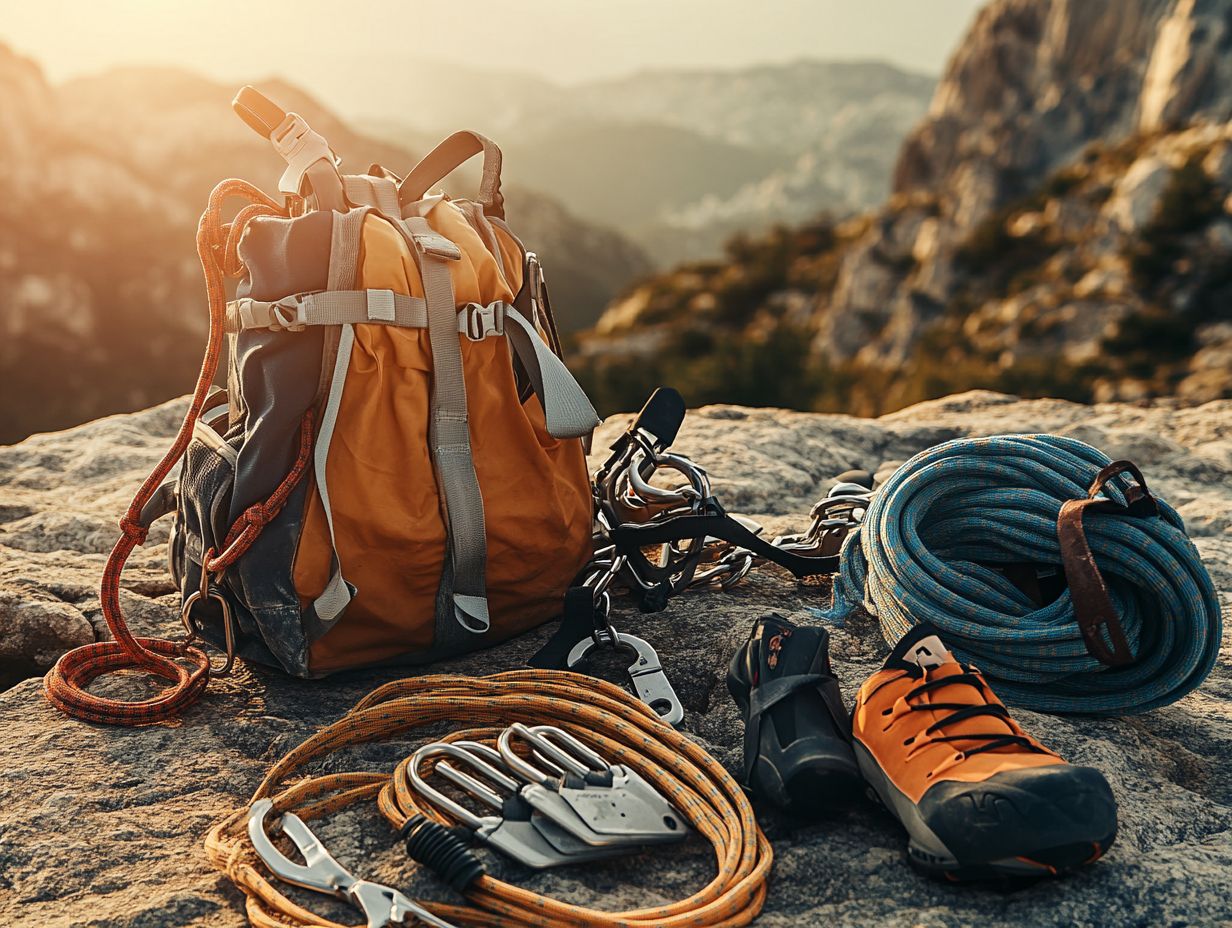
Climbing shoes and chalk bags are not just accessories; they are essential tools that greatly enhance your climbing performance and comfort. A well-fitted pair of climbing shoes hugs your feet snugly, allowing you to maximize your grip on challenging surfaces. Flexible shoes add an extra layer of versatility, making them suitable for various climbing styles.
When paired with a high-quality chalk bag, you can keep your hands optimally dry, reducing common climbing errors and enhancing your overall grip as you ascend.
Selecting the right shoes means understanding the distinction between performance-oriented options that prioritize precision and support for technical routes and more flexible styles designed for comfort on longer climbs. Consider the materials and closure systems of the shoes to achieve that perfect fit. Additionally, knowing what gear is required for rock climbing can enhance your overall experience. On the chalk bag front, choose one with a secure closure and ample volume to avoid messes and ensure easy access during your climb.
Both climbing shoes and chalk bags are crucial to your success. When chosen with care, they not only boost your confidence but also significantly elevate your entire climbing experience.
Optional Gear for Climbing
While essential gear ensures your safety while climbing, optional gear can elevate your overall experience and cater to your specific needs. Accessories like quick-drying clothing, specialized belay devices, and extra protective gear enhance your comfort and convenience during climbs.
If you’re just starting out, knowing which optional gear to invest in can help you cultivate a more enjoyable and successful climbing journey. For instance, understanding hiking safety tips can significantly enhance your experience.
Additional Equipment for Specific Climbing Types
Different climbing styles require specific equipment to maximize both your performance and safety. For instance, if you’re a traditional climber, you may need extra gear like cams and nuts, which are safety gear that helps secure your position. On the other hand, sport climbers typically benefit from quickdraws and additional belay devices.
Joining climbing classes can be incredibly beneficial, offering you tailored insights into the best equipment for each climbing type, including what to know about climbing gear weights, ensuring you’re fully prepared for your adventures.
Understanding the intricacies of climbing routes can greatly enhance your experience, especially if you’re just starting out. If bouldering is your passion, invest in crash pads and climbing shoes that provide optimal grip. Meanwhile, if you’re venturing into mountaineering, specialized gear like ice axes and crampons will be essential for those icy ascents. For a comprehensive overview, check out the top climbing gear for rock climbers.
As a beginner, choose simpler routes with plenty of holds and stable footing. This approach allows you to build confidence before tackling more challenging climbs. Ultimately, selecting the right equipment goes beyond just boosting performance; it’s a matter of safety and ensuring that your climbing experience is fun and rewarding. To help you stay safe and enjoy your adventures, consider learning how to avoid common climbing gear mistakes, no matter your skill level.
How to Choose the Right Gear
The right gear can transform your climbing experience! Selecting climbing gear profoundly impacts your performance, making it essential to consider various factors before finalizing your purchase. Evaluate gear based on your specific climbing style, experience level, and individual needs to ensure the equipment aligns perfectly with your unique requirements.
Take the time to adjust the fit of your harnesses and shoes. This can prevent discomfort and significantly enhance your performance during climbs. By following expert climbing advice, you can make informed decisions that pave the way for a successful climbing journey.
Don t wait to upgrade your gear every climb should be a thrilling adventure!
Factors to Consider When Purchasing Climbing Gear
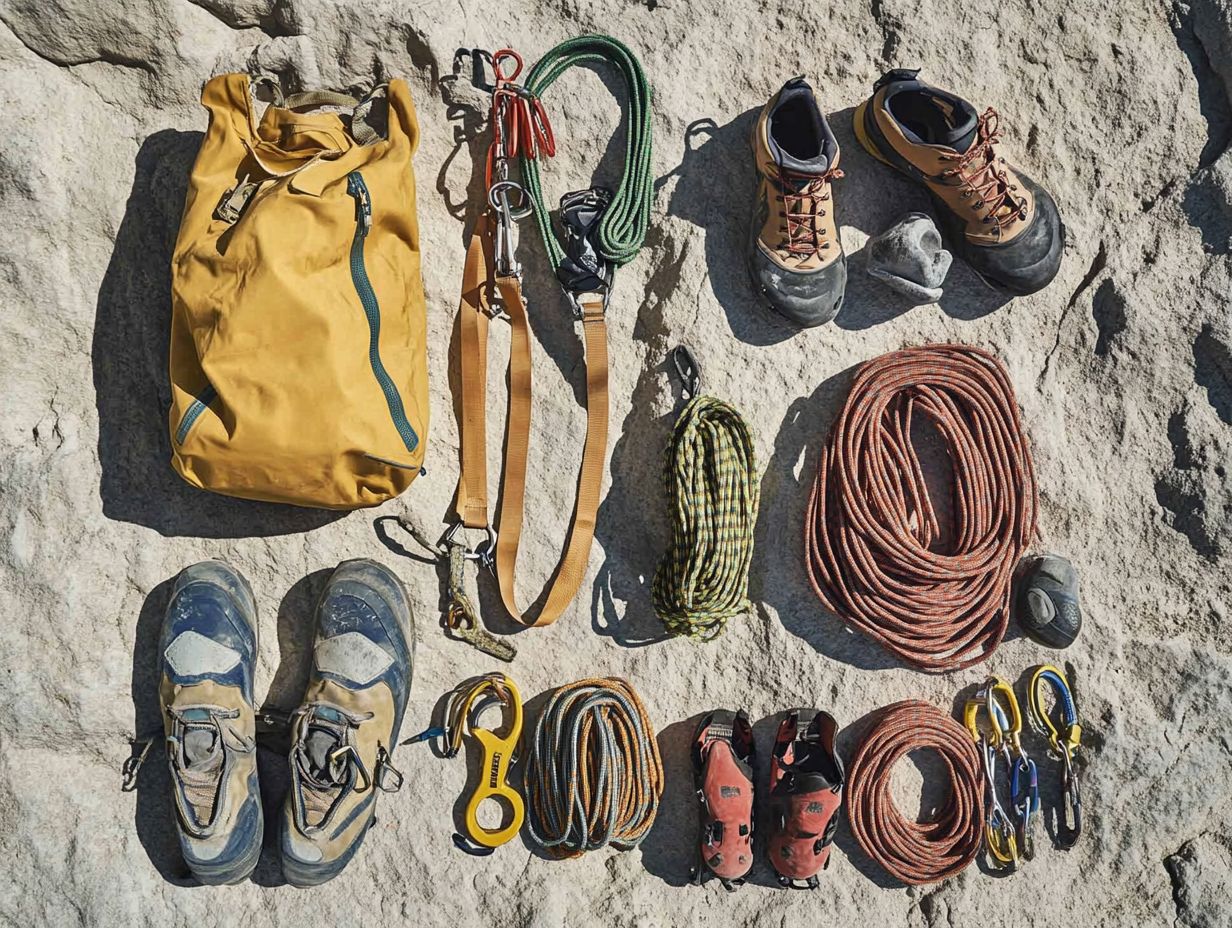
When you re in the market for climbing gear, several critical factors deserve your attention to ensure both safety and performance during your ascents. First and foremost, evaluate the durability of the equipment it s essential for your climbing safety.
Selecting a comfortable harness is equally important; it significantly affects how long you can maintain your climb without discomfort. Performance features, like the stiffer sole of climbing shoes, are vital for optimizing your climbing techniques and enhancing your overall experience. Additionally, knowing top tips for caring for your climbing gear can help ensure your equipment lasts longer and performs at its best.
Don’t overlook the weight of the gear; opting for lighter options can make a noticeable difference, especially on long ascents. Weather resistance in materials is another factor to consider, ensuring your equipment remains effective regardless of the conditions. For those new to the sport, knowing how to choose climbing gear for rock climbing is essential. Pay close attention to the fit and adjustable features of items like helmets and gloves to guarantee maximum safety.
Conduct thorough research on brands known for quality and reliability. This will offer insights from fellow climbers, especially when it comes to understanding the different types of climbing gear, allowing you to make informed decisions based on trusted recommendations.
Caring for and Maintaining Climbing Gear
Proper care and maintenance of climbing gear are crucial for your safety and the longevity of your equipment. Regularly inspect your climbing harnesses, ropes, and helmets for any signs of wear and tear. This can significantly reduce the risk of accidents and enhance your overall climbing experience.
Use the right cleaning techniques for your chalk bags and gear to keep everything in top condition. This allows your equipment to perform effectively for years to come.
Tips for Prolonging the Lifespan of Your Gear
To ensure your climbing gear enjoys a long and fruitful life, implementing effective maintenance tips is very important. Regularly inspect for signs of wear like fraying ropes or cracks in your helmet to maintain both safety and performance during your climbs.
Store your equipment in a cool, dry place, away from direct sunlight, to prevent wear and tear caused by environmental factors.
Cleaning your gear after each adventure can significantly extend its lifespan. For example, washing ropes with mild soap and water removes dirt and grime, while regularly inspecting and wiping down carabiners keeps debris at bay.
Additionally, monitor your harness for any signs of damage. Ensure that buckles and stitching remain secure. Investing in durable equipment enhances your safety and leads to long-term savings, as well-maintained gear performs better and can withstand the challenges of your outdoor escapades.
Frequently Asked Questions
What is considered essential climbing gear?
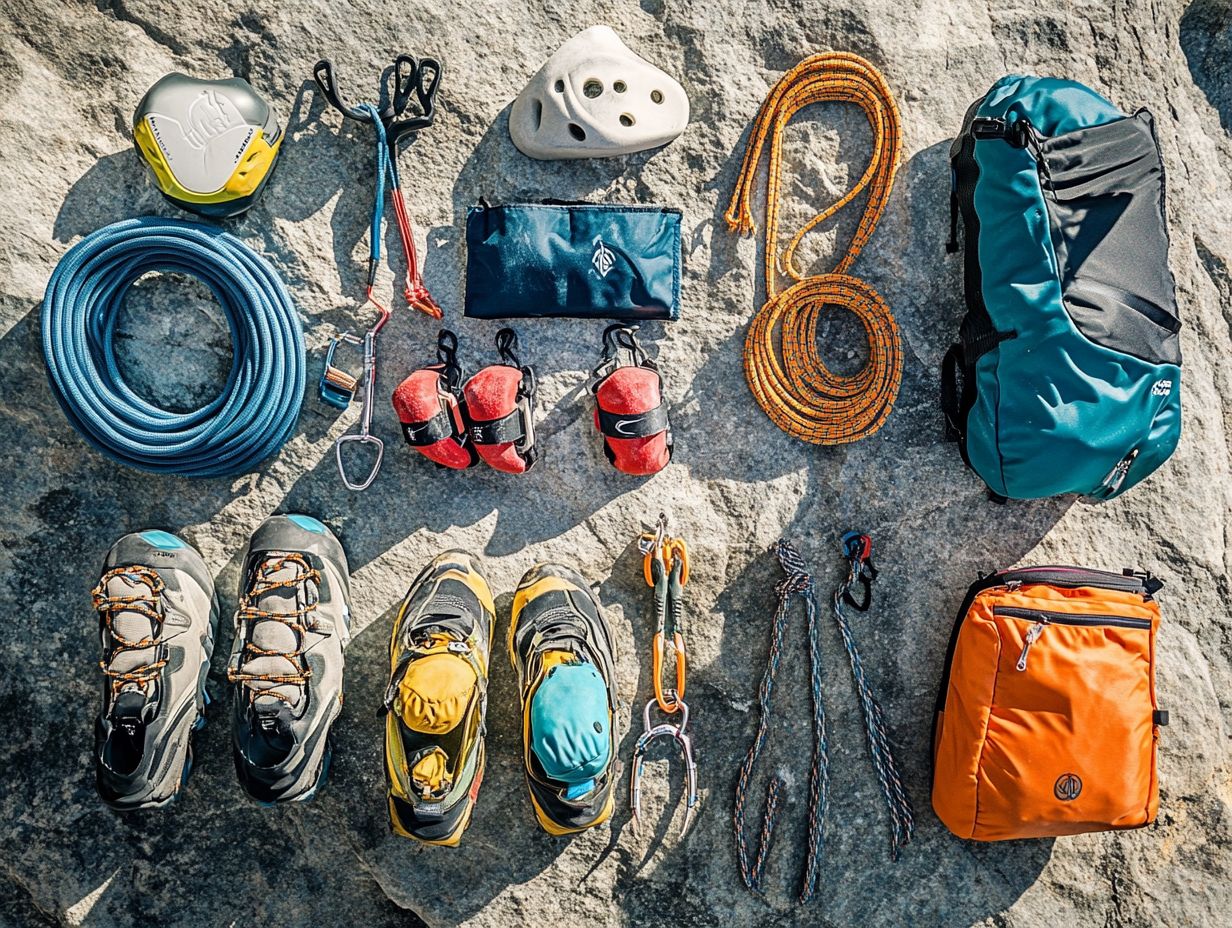
Essential climbing gear includes a beginner’s gear: a climbing harness, climbing shoes, a helmet, a belay device, and a rope. These items are crucial for safety and aid in successful climbs.
What are the different types of climbing shoes?
There are three main types of climbing shoes: neutral, moderate, and aggressive. Neutral shoes are all-around shoes suitable for beginners; moderate shoes have a slight downturn for intermediate climbers, and aggressive shoes have a significant downturn for advanced climbers.
How do I properly fit a climbing harness?
To properly fit a climbing harness, loosen all straps and put it on with the waist belt above your hips and the leg loops snug but not tight. Tighten the waist belt and leg loops to fit comfortably, ensuring you can fit two fingers between the harness and your body.
Start your climbing journey today!
What is the difference between dynamic and static ropes?
Dynamic ropes stretch to absorb the impact of a fall. This makes them safer for climbing.
Static ropes are sturdy and do not stretch, making them suitable for rappelling.
Always use a dynamic rope when climbing to ensure your safety.
How often should I replace my climbing gear?
Keep your climbing gear safe! Replace it every 3-5 years, depending on usage.
Regularly inspect your gear for any signs of damage. If you notice any wear and tear, it’s time to retire the gear.
What is the best way to clean and maintain climbing gear?
To clean and maintain your climbing gear, follow the manufacturer’s instructions. Use mild soap and water to clean ropes and slings.
Always check for signs of damage, and remember to store your gear in a dry, cool place when not in use.

